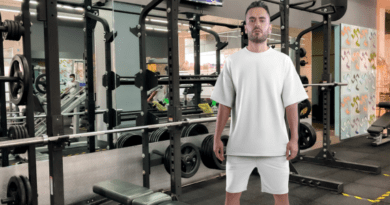Resistance Bands: Must-Have Equipment for Your Home Gym
Ever had one of those days where you plan to hit the gym, but life gets in the way? You’re not alone. Whether it’s a hectic work schedule, crazy weather, or just not having a gym membership, finding time for fitness can be a challenge. That’s where resistance bands become your secret weapon for a great home gym workout.
The market for these simple yet powerful tools is booming, with one 2025 Straits Research report projecting it to grow to over $5 billion by 2033. This explosive growth means there are more brands and varieties than ever, which can feel overwhelming.
But here’s the good news: a quality set of resistance bands is one of the smartest investments for your health. You can build a powerful home gym without dedicating an entire room to bulky, expensive equipment. For more ideas on fitting fitness into a busy schedule, check out these Home Workout Tips for Busy Moms.
In my two decades as a certified strength and conditioning coach, I’ve seen firsthand how effective these simple tools can be. This guide will break down why resistance bands are a must-have piece of equipment and show you exactly what to look for to get the best results.
Disclaimer: This article is for informational purposes only and is not meant to treat or diagnose any condition. It is recommended that you speak with your healthcare professional before engaging in an exercise program to ensure you are healthy enough to do so.
Table of contents
Key Takeaways
- Resistance bands are a versatile and effective tool for building strength, with studies showing they can produce similar gains to conventional gym equipment.
- They are perfect for home gyms because they are inexpensive, take up almost no space, and are safe for all fitness levels.
- Different types of bands, like tube, loop, and fabric bands, serve different purposes, so choosing the right one depends on your workout goals.
- Bands provide constant tension on the muscles through the full range of motion, which can lead to better muscle activation and growth.

Why Resistance Bands?
Resistance bands are an incredibly effective and versatile piece of workout equipment suitable for any fitness level, age, or gender. Whether you’re a seasoned athlete or just starting your fitness journey, you can get a fantastic workout with them.
Related Article: The No-Excuse At-Home Resistance Band Workout
Here are the key benefits that make resistance bands a non-negotiable for your health and fitness program.
1. They take up minimal space
It doesn’t matter if you live in a spacious house or a small apartment, resistance bands are the ultimate space-saving workout tool. A complete set of tube bands with handles often weighs less than five pounds and can be stored in a small drawer or closet, making them perfect for decluttering your workout area.
2. Anyone can use resistance bands
From kids to seniors, resistance bands are a safe and effective tool for everyone. Their low impact on the joints makes them a favorite in physical therapy settings for injury recovery. Organizations like the American Council on Exercise (ACE) recommend them for various populations because the intensity can be easily adjusted to match any fitness level.
3. They are inexpensive
Building a home gym can be a serious investment, but bands are incredibly budget-friendly. You can find high-quality sets on sites like Amazon or at retailers like Target for a fraction of the cost of dumbbells or a gym membership.
- Starter Sets: A basic set of loop bands from brands like Fit Simplify can cost as little as $15-$20.
- Comprehensive Sets: A more complete set with handles, door anchors, and multiple resistance levels, like the Whatafit Resistance Band Set, often retails for under $50.

4. You can work every body part
Just like dumbbells, resistance bands are incredibly versatile, allowing you to train your entire body. You can target every major muscle group, including your legs, arms, shoulders, chest, back, and core. They are also fantastic tools for warming up before a lift or stretching your muscles after a tough workout.
A 2019 study published in SAGE Open Medicine confirmed that training with resistance bands can provide strength gains similar to using conventional gym equipment like weight machines.
5. They provide a full range of motion and constant tension
Unlike free weights, where momentum can sometimes take over and release tension from the muscle, resistance bands provide constant tension throughout the entire exercise. This concept is known as “variable resistance,” where the resistance increases as the band is stretched. This increased time under tension can lead to greater muscle activation and growth, challenging your muscles through the full range of motion.
6. They can travel with you
Do you travel for business or take frequent vacations? There’s no need to skip your workout. Resistance bands are lightweight and compact enough to toss in your suitcase or carry-on bag. The Transportation Security Administration (TSA) permits exercise bands in your luggage, so you can easily get a workout in your hotel room no matter where you are.
What Type of Resistance Bands Should You Look For?
With so many options on the market, choosing the right resistance bands comes down to your fitness goals and personal preference. The three main types are tube bands, loop bands, and fabric bands. Each has its own unique advantages.
Related Article: Exercise Bands — The MOST Ideal Home Gym Equipment
| Band Type | Best For | Key Feature |
|---|---|---|
| Tube Bands with Handles | Simulating gym machine exercises (e.g., chest press, rows, bicep curls). | Comfortable grips and attachments like door anchors make them versatile for upper body workouts. |
| Loop Bands (Latex) | Assisted pull-ups, stretching, and adding resistance to bodyweight exercises like squats. | A continuous loop that comes in various thicknesses to provide a wide range of resistance levels. Rogue Monster Bands are a popular choice. |
| Fabric Bands (Booty Bands) | Lower body exercises like squats, hip thrusts, and glute bridges. | Made of comfortable fabric with a non-slip grip, they stay in place on your legs better than latex bands. |
If you’re looking for a high-quality option that combines comfort and durability, fabric resistance bands are an excellent choice. The DMOOSE Fabric Resistance Bands are a great example.
The DMOOSE Fabric Resistance Bands are made from a thick, high-quality fabric that is both sturdy and comfortable against the skin. They are available in a three or five-band set, allowing you to choose the resistance level that matches your needs.
These bands are lightweight, portable, and color-coded by resistance level, making them easy to identify. Plus, the set comes with a convenient storage bag and an exercise guide, which is perfect for beginners. Now you have everything you need to get a great workout at home or on the go.
*This article was sponsored by DMOOSE.
Resistance Bands FAQs
Can you actually build muscle with resistance bands?
Absolutely. Research has consistently shown that training with resistance bands can stimulate muscle growth just as effectively as free weights or machines when the intensity is matched. The key to building muscle, a process called hypertrophy, is creating mechanical tension and metabolic stress, both of which bands do very well.
How do I choose the right resistance level?
Most brands color-code their bands, but the colors can vary, so always check the packaging. As a general rule, you should choose a resistance level that allows you to complete 8-15 repetitions with good form. The last few reps should feel challenging but not impossible. It’s a good idea to buy a set with multiple resistance levels, as you’ll need lighter bands for upper body exercises and heavier ones for your lower body.
How often should I use resistance bands?
The American College of Sports Medicine (ACSM) recommends strength training at least two non-consecutive days per week, targeting all major muscle groups. You can follow this guideline with resistance bands. For beginners, a full-body workout two to three times per week is a great starting point. Just be sure to listen to your body and allow for adequate rest between sessions.



*Disclosure: This article may contain affiliate links or ads, which means we earn a small commission at no extra cost to you if you make a purchase through these links. These commissions help support the operation and maintenance of our website, allowing us to continue producing free valuable content. Your support is genuinely appreciated, whether you choose to use our links or not. Thank you for being a part of our community and enjoying our content.
PLEASE CONSIDER SHARING THIS ON YOUR SOCIAL MEDIA TO HELP OTHERS LEARN MORE ABOUT THIS TOPIC.





